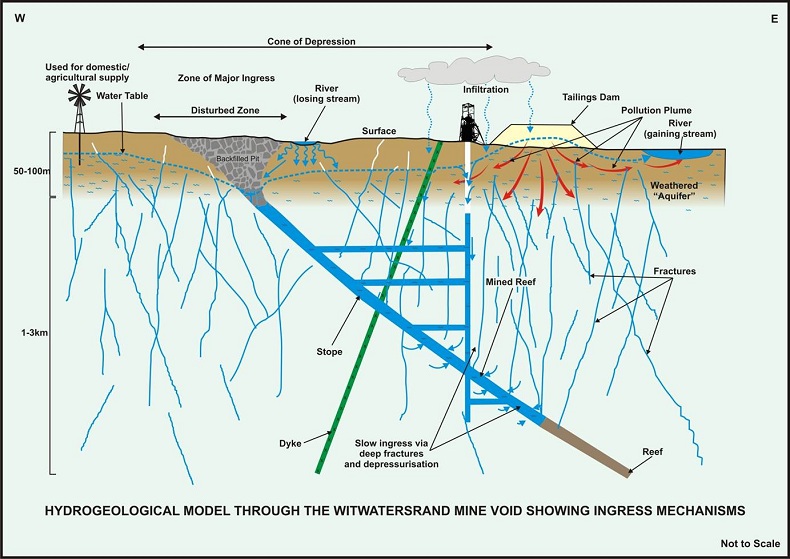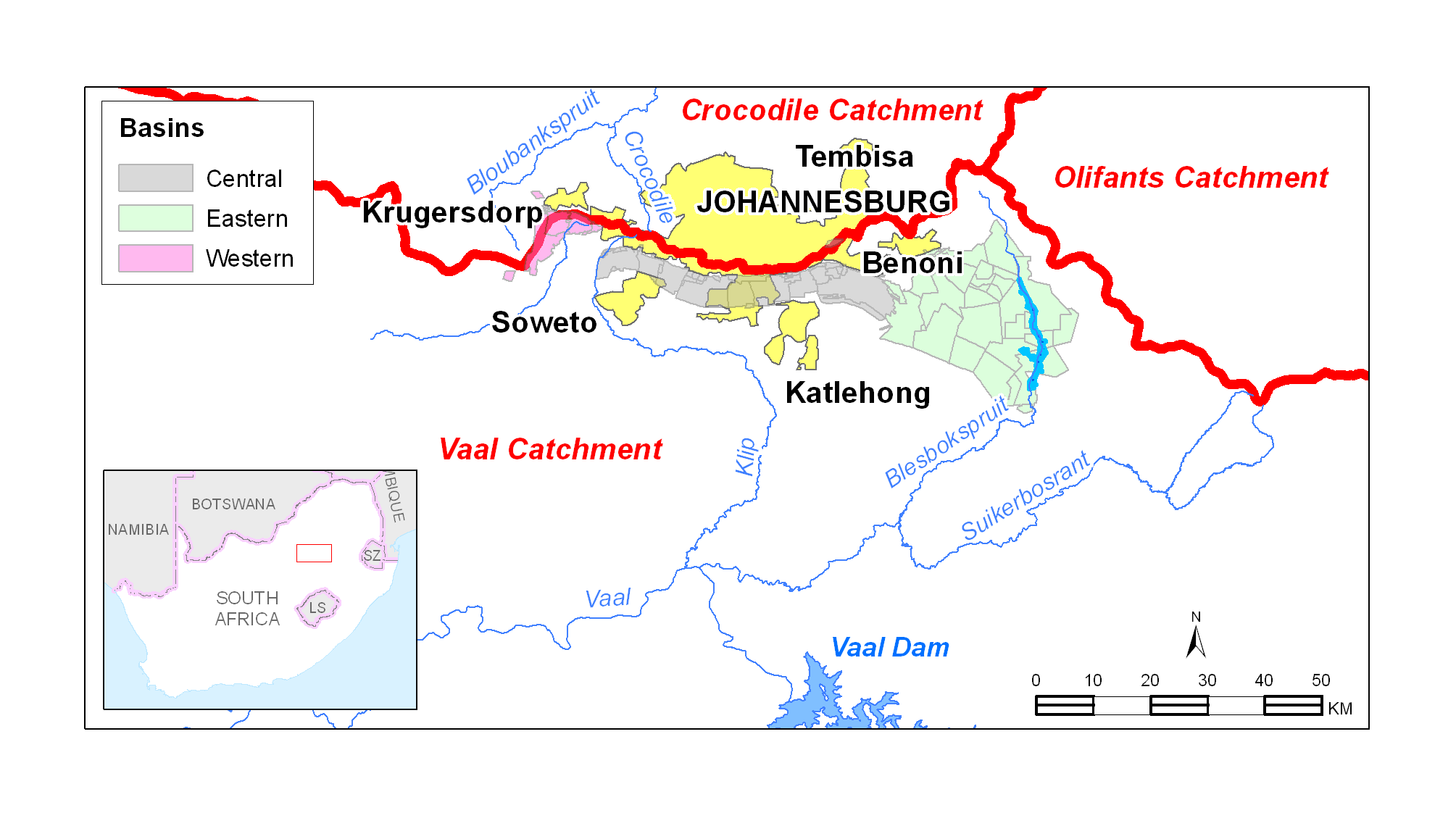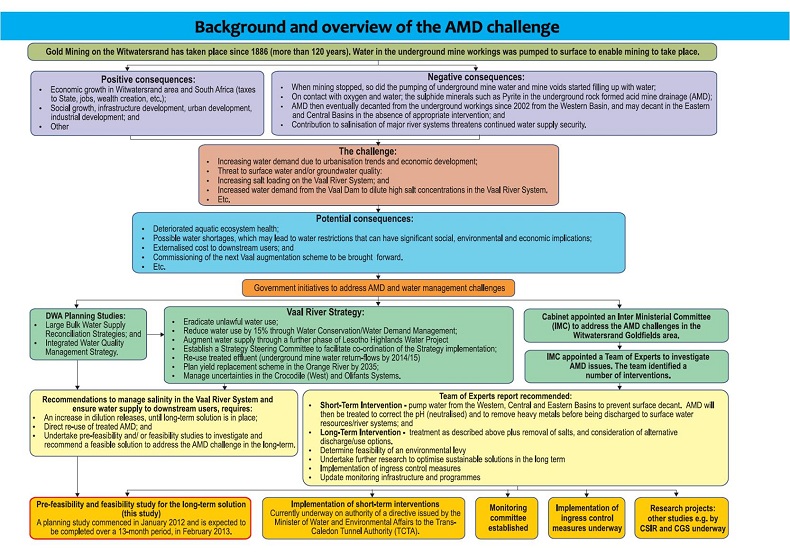FEASIBILITY STUDY FOR A LONG-TERM SOLUTION TO ADDRESS THE ACID MINE DRAINAGE ASSOCIATED WITH THE EAST, CENTRAL AND WEST RAND UNDERGROUND MINING BASINS
THE NATURE OF ACID MINE DRAINAGE
Acid Mine Drainage (AMD) is generated when sulphide bearing minerals, often in
the form of pyrite (which is iron-sulphide or FeS2 found inter alia in reefs
mined for gold), are exposed to oxygen and water. This process, termed pyrite
oxidation, is characterised by the generation of sulphuric acid and dissolved
iron, as illustrated with a typical chemical reaction depicted below.

Apart from iron, the associated decreasing pH is also conducive to the
mobilisation of various other metals, such as copper, lead, aluminium, manganese
and uranium. Although the AMD generating reactions also occur in abiotic
environments, colonies of microorganisms, such as certain acidophiles (bacteria
thriving under acidic conditions), greatly accelerate the decomposition of metal
ions. When the pH of AMD is raised, either through contact with fresh water or
with neutralising minerals, metals, such as the previously soluble iron(III)
ions precipitate as iron(III) hydroxide – a yellow-orange solid colloquially
known as “yellow boy”.

MINING’S “WATER” LEGACY
In the Witwatersrand area, in the Province of Gauteng, mining has taken place in
the three underground mining basins of the East, Central and West Rand since the
discovery of gold in 1886. It was the driving force of the economic growth and
development of what is Gauteng today and it was the backbone of the economy of
South Africa for many years. During this time the more than 120 mines would have
been required to pump out the water that had entered the mines in order to allow
for safe mining conditions. As the mines were worked out and were abandoned,
dewatering of the mine voids became the responsibility of fewer and fewer mines,
and the voids (tunnels, drives and shafts) started filling with water. The
mechanism through which this occurs is illustrated conceptually below:

AMD, generated through the ingress of water into the mine voids, is generally
characterised by one or more of the following: low pH, high salt content (mostly
made up of sulphates), and high levels of metals – particularly iron (giving it
the red-orange colour). In cases where uranium is present, radiological risks
may also be present.
As the water levels in the mine voids rise, the risk of possible seismic activity
(i.e. tremors) increases, AMD can contaminate shallow aquifers, and if the
underground mine water reaches the near-surface environment, geotechnical
impacts (i.e. such as sinkhole formation) may potentially be caused. The
uncontrolled rising of the underground mine water levels may also cause negative
socio economic consequences, such as the potential flooding of the Gold Reef
City underground museum and the possible sterilisation of remaining gold
reserves. Once the AMD reaches the surface and starts to decant, as was the case
since 2002 until recently in the Western Basin, it flows down to wetlands,
streams and rivers, and mortality of aquatic biota may occur. Since our rivers
are inter alia used as a water source for the supply of water for agriculture,
recreation and drinking purposes, AMD potentially affects the fitness for use of
such water. AMD can also have a cost implication further downstream due to
elevated salt levels that may be caused.
MINING AND WATER SECURITY IN THE VAAL RIVER WATER SUPPLY AREA
If the salt loading on the Vaal River System associated with the discharges of
AMD from mines and sewage effluent are not eliminated or suitably reduced,
excessive dilution-releases from the Vaal Dam will be required to achieve the
Resource Water Quality Objectives in the Vaal Barrage and downstream river. This
will result in unusable surpluses developing in the Lower Vaal River,
potentially externalising the cost of pollution to the Lower Orange River.
Should the AMD issue, and specifically the increasing salt loading caused in the
Vaal River System, not be addressed appropriately, the acceptable levels of
assurance of water supply may be threatened in the up-coming years. Although
being dependent on the rain and runoff experienced in a moving 2 year period,
this means that there will be an increasing risk of water restrictions that may
have to be imposed on Vaal River water users. See the Vaal Position Paper
for more information...

ADDRESSING AMD
In order to address the AMD threats responsibly, DWA, together with a number of
other departments such as DMR have initiated a number of interventions and
studies (included in the diagram below). Each of these initiatives is aimed at
solving a particular part of the problem.

The Inter-Ministerial Committee (IMC) on AMD, comprising of the Ministers of
Mineral Resources, Water and Environmental Affairs, Science and Technology and
the Minister in the Presidency: National Planning Commission directed that a
Team of Experts investigate solutions to the AMD related challenges associated
with various Gauteng gold mines. Following this, Cabinet, on 9 February 2011
accepted the IMC report
and instructed that a number of steps be taken. The Department of Water Affairs
(DWA) has subsequently implemented the following steps to address the problem:
On 6 April 2011, the Trans-Caledon Tunnel Authority (TCTA) was instructed to
undertake emergency works to protect the respective Environmental Critical
Levels (ECLs) in the Eastern and Central Basins and to lower the underground
mine water levels in the Western Basin; and to neutralise and remove the heavy
metals from the pumped underground mine water prior to it being released to
surface water resources; A Hydrological Monitoring Committee (HMC) was established under the
chairmanship of DWA to monitor the re-watering and quality of water, in respect
of the East, Central and West Rand. The Council for Geoscience (CGS), the
Department of Mineral Resources (DMR) and the Council for Scientific and
Industrial Research (CSIR) are also involved; and A Feasibility Study to address underground mine water induced salt loading
of major river systems in the long-term was initiated on
1 February 2012.
FINDING LONG-TERM SOLUTIONS
In addition to the Short-Term Interventions and Ingress Control Interventions a “Feasibility Study for a long term solution to address the AMD associated with the East, Central and West Rand underground mining basins”
was initiated. This study, which was concluded on the 31 July 2013, consisted of
three phases, i.e. the Initiation Phase, the Prefeasibility Phase and a
Feasibility Phase. Details on the scope of the Feasibility Study can be obtained
from the Inception Report, a list of the study deliverables can be obtained from the Study Approach
page and copies of the reports and other documents can be obtained from the documents
page.
The outcomes of the study are summarised in Newsletter 3. More in-depth
information on the long-term solution to address the AMD associated with the
underground mining basins in the Witwatersrand can be found in the Feasibility Report (study report No. 10) and Implementation Plan
(Study Report No.8).
50903
|